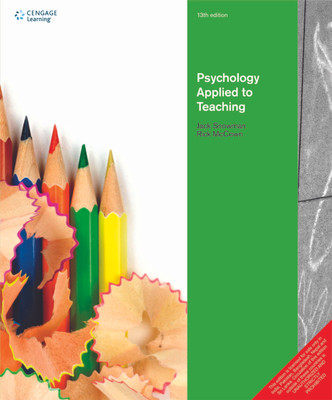Psychology Applied to Teaching 13th Edition(English, Paperback, Rick McCown, Jack Snowman)
Quick Overview
Product Price Comparison
This text has received wide acclaim for its practical and reader-friendly approach to educational psychology, which demonstrates how complex psychological theories apply to the everyday experiences of in-service teachers. Coverage of educational psychology is framed so that aspiring or developing teachers can see themselves as professionals who continuously seek, find, and test better ways to help their students succeed. PSYCHOLOGY APPLIED TO TEACHING, combines fresh concepts and contemporary research with long-standing theory and applications to create a book that addresses the needs of todays teachers and students. Key Features New! Emphasis on inquiry through assessment: Based on recent research on designs for teaching and learning, the role of teacher inquiry and how it is supported through formative assessment practices is addressed. Formative assessments role in reflective teaching is discussed in Chapters 1 and 16. A new definition of formative assessment tied to both student and teacher learning anchors a new section in Chapter 14. New! Advances in social cognitive theory, particularly with respect to self-regulated learning: Chapter 9 includes extensive coverage of learning strategies and tactics, and how students can be taught to create and use them. Cited research on a program of self-regulation designed to strengthen writing skills shows how the principles of self-regulated learning can be applied in the classroom. New! Emphasis on diverse learners: To help teachers understand and cope with the wide range of student diversity they will almost certainly face, the book includes extensive treatment of this issue in Chapter 4, Understanding Student Differences, and Chapter 5, Addressing Cultural and Socioeconomic Diversity. Chapter 6, Accommodating Student Variability, shows how principles of universal design for learning (UDL) are being employed via technology. Teaching ideas specific to diversity (e.g., emerging work on critical constructivism in Chapter 10) appear in other chapters as well. New! Emphasis on educational technology: Each chapter contains at least one section on how technology can be used to address the chapters themes. Topics include the impact of Web 2.0 technologies and how they can be used to foster cognitive development, promote multicultural understanding, make learning easier for students with disabilities, boost motivation, help teachers manage classrooms, and aid in assessment. Current design research appears across chapters, including a major project on a multi-user virtual environment (MUVE) called Quest Atlantis. New! New coverage of current topics and research findings includes information on bullying, cyber-bullying, and school violence and interventions; the caring orientation to moral development (e.g., Nel Noddings Care Theory); contemporary views of intelligence; and Response to Intervention and its implications for assessment. New! Other new and updated topics include a second alternative (Marzano & Kendall) to Blooms Taxonomy; how social networking and blog websites can support the goals of a social constructivist approach to learning and tie to cooperative and collaborative learning; formative assessment and the distinction between assessment of learning, assessment for learning, and assessment as learning; recent DOE modifications to laws and NCLB; and more. Suggestions for Teaching provide concrete teaching examples that highlight the application of psychological research in the classroom. This real-world connection helps pre-service teachers understand the value of their Educational Psychology course in their development as an educator. For ease of reference, these sections are printed on a colored background and tabbed. Teach Source Video Case boxes integrate the text with award-winning video cases, bringing key topics to life and simulating classroom observation by referring students to relevant cases that they can view online. Case in Print presents a recent newspaper article in every chapter, illustrating the relationship between chapter content and real-life classroom practices. Take a Stand! provides students with brief models of how to articulate a compelling position on an educational issue. Pause & Reflect sections prompt students to stop and think about a concept, make connections between concepts, and relate theory and actual classroom practice. These features also encourage students to relate their own experiences to what they are reading. Journal Entries encourage readers to prepare a personal set of guidelines for reference before and during the student teaching experience and during the first years of teaching. Chapter 16, Becoming a Better Teacher by Becoming a Reflective Teacher, features a guide for setting up and using a Reflective Journal. Revealing & Challenging Your Assumptions chapter-opening vignettes encourage aspiring teachers to confront and reflect on problematic assumptions about teaching and learning--and to understand how and why the assumptions could be an obstacle to effective teaching. Table of Contents Applying Psychology to Teaching. Part I: Student Characteristics. 2. Theories of Psychosocial and Cognitive Development. 3. Age-Level Characteristics. 4. Understanding Student Differences. 5. Addressing Cultural and Socioeconomic Diversity. 6. Accommodating Student Variability. Part II: Learning and Instruction. 7. Behavioral Learning Theory: Operant Conditioning. 8. Information Processing Theory. 9. Social Cognitive Theory. 10. Constructivist Learning Theory, Problem Solving, and Transfer. Part III: Creating a Positive Learning Environment. 11. Motivation. 12. Classroom Management. 13. Approaches to Instruction. Part IV: Assessing of Students. 14. Assessment of Classroom Learning. 15. Understanding and Using Standardized Tests. 16. Becoming a Better Teacher by Learning from Teaching.


